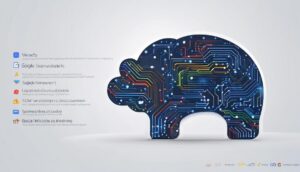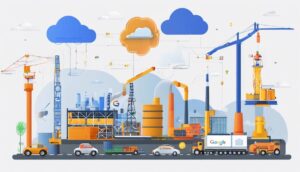
Google Machine Learning: Unleashing Cloud Capabilities
What is Google machine learning and how does it work?
Google machine learning is a branch of artificial intelligence that enables computer systems to learn and improve from experience without being explicitly programmed. It works by using algorithms to analyze large datasets, identify patterns, and make predictions or decisions based on the learned information.
What is Google machine learning and how does it work
In the realm of cloud computing and artificial intelligence, Google Cloud’s Machine Learning capabilities stand out prominently with their elevated functionality and versatility. These sophisticated tools offer a comprehensive set of solutions for a wide array of domains, leveraging the power of machine learning algorithms and models.
The prowess of Google Cloud Machine Learning goes beyond its technological mechanisms, providing seamless integration into existing architectural frameworks, thereby ensuring its applicability across different sectors. To explore these features in-depth, we will examine the design and makeup of Google Cloud ML, delve into different machine learning models and algorithms, explain how it melds with current systems, and delve into real-world applications where Google Cloud’s ML has proven its worth for learners.
Overview of Google Cloud Machine Learning
Looking at the current trajectory of the tech-game, there’s no missing the thunderous impact of the Google Cloud’s Machine Learning abilities. Known for rallying forth transformative technology, Google has paved the way for another revelation that’s shifting paradigms of how information and data are utilized. Let’s dive right in and analyze the basic elements of Google Cloud’s Machine Learning capabilities.
1. Google Cloud AutoML:
Simplifying machine learning models for developers, Google Cloud AutoML is a suite of machine learning products that enable developers with limited machine learning expertise to build high-quality models. Built on Google’s state-of-the-art transfer learning and neural architecture search technology, AutoML offers productivity-oriented tools to effortlessly train custom models.
2. BigQuery ML:
BigQuery Machine Learning (BQML) empowers data analysts to create and execute machine learning models on vast, processed, and structured data directly within BigQuery using standard SQL queries. There’s no need to move the data; convenient and efficient, isn’t it?
3. Google Cloud ML Engine:
Google Cloud Machine Learning (ML) Engine brings the power and versatility of TensorFlow, a leading, open-source machine learning library, to the Cloud. It supports all phases of the machine learning workflow like data ingestion, data preparation, model training, model evaluation, and prediction.
4. Deep Learning VM Image:
These specialized Virtual Machine images are tailored to run deep learning workloads efficiently and come with key ML frameworks and tools pre-installed. It supports multiple machine types, GPUs and offers seamless integration with Cloud tools, aiding fast deployment and manageability.
5. TensorFlow:
TensorFlow is an open-source software library for machine learning applications like neural networks. It provides a flexible framework to design, build, and train models across a range of tasks and directly supports Google Cloud’s ML architecture.
6. Dialogflow:
Blurring the lines between humans and tech, Dialogflow deploys Google’s machine learning expertise to recognize and understand a user’s intention from their text or voice inputs. It’s integrated with Google Cloud Speech-to-Text, enabling developers to build interactive voice and text-based conversational interfaces.
Google Cloud’s Machine Learning capabilities harness the power of Artificial Intelligence, Machine Learning and Big Data Analytics, providing a more holistic, efficient platform for developers. They set the path for innovative solutions in every sector, from healthcare to finance, retail, and more. With an analytical, problem-solving lens, it’s evident that these tools are far more than just technological upgrades – they’re a transformation, redefining the boundaries of what’s possible through real-world case studies.

Machine Learning Models and Algorithms
Exploring Google Cloud’s Suite of Advanced Machine Learning Models and Algorithms
The world of Machine Learning (ML) and Artificial Intelligence (AI) has been evolving exponentially, with Google Cloud Platform (GCP) standing out as a frontrunner wherein it offers an extensive range of ML models and algorithms. Beyond the highly acclaimed tools such as AutoML, BigQuery ML, and the Deep Learning VM Image, Google Cloud’s technology ecosystem has so much more to offer, including best practices for implementing machine learning on Google Cloud.
To begin with, the Google Cloud Video AI models enable users to extract valuable data from videos. They accurately identify a comprehensive list of potential objects within a video – ranging from recognizing animals and food items to detecting changes in landscape. For businesses, this technology can uncover insights that plain manual viewing might miss.
Then we have Cloud Natural Language, a form of machine learning technology that analyses and understands text. A prime example of how Google is blending AI with real world applications, this tool has been built to comprehend human language through natural language understanding. Apart from parsing syntax, it also understands sentiments, making it a phenomenal tool for businesses to evaluate customer sentiments on social media and beyond.
Google Cloud’s Translation API, another impressive machine learning tool, deciphers text input into other languages. Boasting broad language support, it helps businesses improve user communication across different geographical locations. This technology is a significant step towards breaking down language barriers and fostering global connections.
The power of predictive modeling is harnessed by Google Cloud’s Recommendations AI. This system, born out of Google’s years of experience in recommendation systems, helps businesses create personalized recommendations for their consumers. Recommendations AI analyses customer user behavior data to predict future likes and dislikes, thereby maximizing customer satisfaction and driving sales in retail outlets through the use of advanced classification models and algorithms.
Cloud Vision API, acutely focused on image analysis, also brings unparalleled value to the table. It identifies a multitude of characteristics in images, such as detecting emotions on human faces, characterizing handwriting, recognizing logos, and even identifying landmarks. Visual data is invaluable, and with Cloud Vision, businesses can capitalize on this data to improve service efficiencies and customer experiences.
Diving into the realm of audio, the Google Cloud Speech-to-Text model converts audio to text by applying neural network models. This conversion, backed by pioneering technology, facilitates the generation of detailed speech transcripts and paves the way for improved voice commands and voice-enabled applications.
The astounding range of machine learning models and algorithms provided by Google Cloud empowers businesses to boost functionality, drive efficiency, and enhance user experiences. One thing is clear, with the sheer depth and breadth of machine learning technology on offer from platforms like Coursera, Google Cloud leaves no stone unturned in bringing AI and ML into both everyday life and complex problem-solving.

Integration of Google Cloud into Existing Architecture
There’s little denying the appeal of Google Cloud’s Machine Learning (GCM) capabilities. They offer functionality and efficiency that can seamlessly enhance any tech enthusiast’s existing setup. But it isn’t always clear how to integrate these features without disrupting workflows. Fear not, we’re here to simplify that.
First, it’s pertinent understanding one of the major players – Cloud Functions. It’s a feature of GCM that allows you to run code in response to events triggered by Google Cloud Services. It’s the best choice for real-time file processing, turning heavy architectures into lightweight, event-driven systems. Be it processing logs from Cloud Logging or reacting to messages from Cloud Pub/Sub, Cloud Functions fosters integration like a breeze.
Next, Firebase ML. While not as well-known as its counterparts, it’s a hidden tool that comes in handy for mobile app developers. Firebase can integrate with GCM to add machine learning services in mobile apps. It allows the use of powerful on-device vision services, AutoML Vision Edge, and even custom TensorFlow Lite models.
Meet Kubeflow Pipelines. It’s an answer for those who appreciate the containerized setup of Kubernetes. Here, you can create, deploy, and run scalable machine learning workflows based on Docker containers. Kubeflow Pipelines is tightly integrated with Google Cloud and serves as a powerful instrument to weave GCM into existing Kubernetes-based architectures.
AI Hub is your place to find, share and deploy artificial intelligence components in GCM – including end-to-end AI pipelines and out-of-the-box algorithms. It’s a one-stop, user-friendly repository that streamlines the machine learning workflow and accelerates the pace at which models are developed and implemented.
There’s also Google Cloud Datastore. It’s a highly-scalable and fully-managed NoSQL database that serves as an excellent storage for Machine Learning models. With its seamless data integration and real-time analytics, the Cloud Datastore ensures you are never working with outdated data.
Artificial Intelligence Platform Notebooks, built on JupyterLab, excels for those looking to create, manage, and share Jupyter notebooks with ease. With its deep integration with BigQuery, Google Cloud Storage, and Google Drive, it offers an ideal environment for building and deploying machine learning models.
Last but not least, Google Cloud Predictive Analytics is worth mentioning for those who want to predict future events and perform pattern matching, providing insights to aid informed decisions.
Seamless integration of GCM does require some work, but as tech enthusiasts, that exploration and problem-solving form part of the thrill. With the right tools in play, one can effortlessly turn these capabilities into enhanced, highly-scalable systems that are not only capable but also efficient and, without a doubt, the future of machine learning. Leveraging these capabilities could see a profound and invaluable impact on your existing architecture.

Analyzing Real-World Applications of Google Cloud Machine Learning
When it comes to real-world applications of Google Cloud Machine Learning, the prospect is both fascinating and expansive. From streamlining supply chain operations to enhancing healthcare diagnostics, Google Cloud ML is helping redefine industry practices around the globe.
Healthcare is one sector where Google Cloud ML has been making significant strides. Using the Google Cloud Healthcare API, organizations can ingest and manage key healthcare data types including HL7, FHIR, and DICOM. The API leverages AI and ML to gain actionable insights from this vast amount of data. It has brought about improvements in diagnostic accuracy and treatment personalization.
The music industry has also been touched by Google Cloud ML. Spotify, for instance, uses Google’s Bigtable database to analyze user behavior and drive personalized recommendations. Data about user habits, song preferences, and playlists are processed on the Google Cloud Platform, resulting in a unique listening experience for each user.
Retail companies are leveraging Google Cloud ML to predict customer behavior and implement predictive marketing strategies. e-commerce giant, eBay, uses Google Cloud ML to translate the listings from its worldwide sellers in real-time, thus simplifying the shopping experience for consumers.
Ascension, the second-largest health system in the U.S., uses Google Cloud’s AI and ML capabilities to analyze data and extract insights, thereby helping clinicians provide better care.
Financial institutions are not left out. HSBC, for instance, deploys Google Cloud ML to combat money laundering. By analyzing vast amounts of transactions data, the system can identify suspicious activity patterns, thus aiding proactive measures against financial fraud.
In the realm of gaming, the leading company, GameLoft, utilizes Google Cloud ML to analyze the behaviour of its players and optimize their gaming experience. Google Cloud’s ML algorithms help GameLoft to dynamically adjust the difficulty of its games, ensuring players remain engaged.
There’s no disputing that Google Cloud ML applications are significantly impacting real-world scenarios. Technology is a powerful force in shaping our world, and with Google Cloud ML providing the muscle, the future of digital transformation looks promising. From healthcare to the music industry, from retail to finance, and even in areas like gaming, Google Cloud ML has made its mark. The applications of this powerful tool are expanding and it seems the surface is just being scratched. The possibilities are thrilling, the journey enlightening; with Google Cloud ML, the world is experiencing a revolution in technology application.

As we navigate the digital landscape, it is crystal clear that Google Cloud’s Machine Learning capabilities hold the potential to revolutionize how processes are handled across various industries. Their collection of ML models and algorithms can help find solutions to complex problems, and their flexibility for integration consolidates their position in the digital world. The power of Google Cloud’s ML has been demonstrated in countless cases within industries ranging from finance and healthcare to e-commerce; each example cemented the value of machine learning and its potential to elevate operations. Therefore, staying apprised of the possibilities that this innovative technology offers is a step into the future, which promises a world powered by intelligent and scalable solutions.
https://cloudonair.withgoogle.com/events/summit-applied-ml-summit-23
https://www.cloudskillsboost.google/paths/17
https://pair.withgoogle.com/guidebook/
https://www.youtube.com/playlist
https://www.reuters.com/technology/gBarcode Scanner App/Readeroogles-ai-power-virtual-travel-agent-priceline-2023-06-06/
